Appearance White amorphous powder Molar mass 78.0036 g/mol Density 2.42 g/cm³ Classification Aluminum compounds | Formula Al(OH)3 IUPAC ID Aluminium hydroxide Melting point 300 °C | |
 | ||
Related compounds Soluble in Acid, Sulfuric acid, Alkali, Hydrochloric acid | ||
Aluminium hydroxide, Al(OH)3, is found in nature as the mineral gibbsite (also known as hydrargillite) and its three much rarer polymorphs: bayerite, doyleite and nordstrandite. Aluminium hydroxide is amphoteric in nature, i.e, it has both basic and acidic nature. Closely related are aluminium oxide hydroxide, AlO(OH), and aluminium oxide (or alumina), Al2O3. Aluminium oxide is also amphoteric in nature. These compounds together are the major components of the aluminium ore bauxite.
Contents
- Nomenclature
- Properties
- Polymorphism
- Production
- Uses
- Fire retardant
- Pharmaceutical
- Potential adverse effects
- References
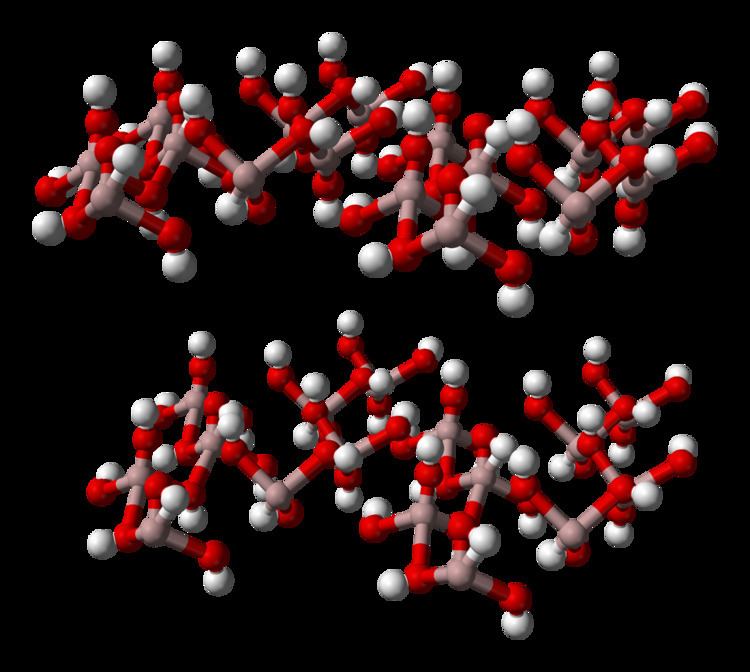
Nomenclature
The naming for the different forms of aluminium hydroxide is ambiguous and there is no universal standard. All four polymorphs have a chemical composition of aluminium trihydroxide (an aluminium atom attached to three hydroxide groups).
Gibbsite is also known as hydrargillite, named after the Greek words for water (hydra) and clay (argylles). The first compound named hydrargillite was thought to be aluminium hydroxide, but was later found to be aluminium phosphate; despite this, both gibbsite and hydrargillite are used to refer to the same polymorphism of aluminium hydroxide, with gibbsite used most commonly in the United States and hydrargillite used more often in Europe. In 1930 it was referred to as α-alumina trihydrate to contrast it with bayerite which was called β-alumina trihydrate (the alpha and beta designations were used to differentiate the more- and less-common forms respectively). In 1957 a symposium on alumina nomenclature attempted to develop a universal standard, resulting in gibbsite being designated γ-Al(OH)3 and bayerite becoming α-Al(OH)3 and nordstrandite being designated Al(OH)3. Based on their crystallographic properties, a suggested nomenclature and designation is for gibbsite to be α-Al(OH)3, bayerite to be designated β-Al(OH)3 and both nordstrandite and doyleite are designated Al(OH)3. Under this designation, the α and β prefixes refer to hexagonal, close-packed structures and altered or dehydrated polymorphisms respectively, with no differentiation between nordstrandite and doyleite.
Properties
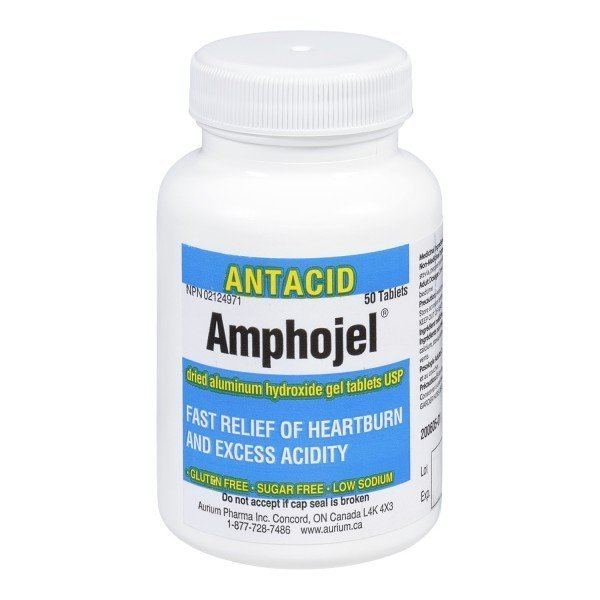
Gibbsite has a typical metal hydroxide structure with hydrogen bonds. It is built up of double layers of hydroxyl groups with aluminium ions occupying two-thirds of the octahedral holes between the two layers.

Aluminium hydroxide is amphoteric. It dissolves in acid, forming [Al(H2O)6]3+ (hexaaquaaluminium) or its hydrolysis products. It also dissolves in strong alkaline solutions, forming [Al(OH)4]− (tetrahydroxidoaluminate).
Polymorphism
Four polymorphs of aluminium hydroxide exist, all based on the common combination of one aluminium atom and three hydroxide molecules into different crystalline arrangements that determine the appearance and properties of the compound. The four combinations are:
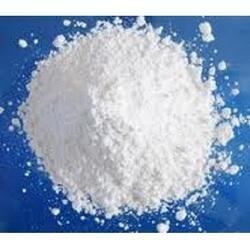
All polymorphs are composed of layers of octahedral aluminium hydroxide units with the aluminium atom in the centre and the hydroxyl groups on the sides, with hydrogen bonds holding the layers together. The polymorphisms vary in how the layers stack together, with the arrangements of the molecules and layers determined by the acidity, presence of ions (including salt) and the surface of the minerals the substance forms on. Under most conditions gibbsite is the most chemically stable form of aluminium hydroxide. All forms of Al(OH)3 crystals are hexagonal.
Production
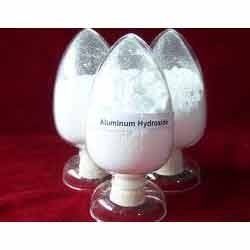
Virtually all the aluminium hydroxide used commercially is manufactured by the Bayer process which involves dissolving bauxite in sodium hydroxide at temperatures up to 270 °C (518 °F). The waste solid, bauxite tailings, is removed and aluminium hydroxide is precipitated from the remaining solution of sodium aluminate. This aluminium hydroxide can be converted to aluminium oxide or alumina by calcination.
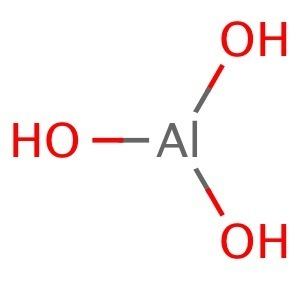
The residue or bauxite tailings, which is mostly iron oxide, is highly caustic due to residual sodium hydroxide. It was historically stored in lagoons; this led to the Ajka alumina plant accident in 2010 in Hungary, where a dam burst led to the drowning of nine people. An additional 122 sought treatment for chemical burns. The mud contaminated 40 square kilometers of land and reached the Danube. While the mud was considered non-toxic due to low levels of heavy metals, the associated slurry had a very high pH of 13.
Uses
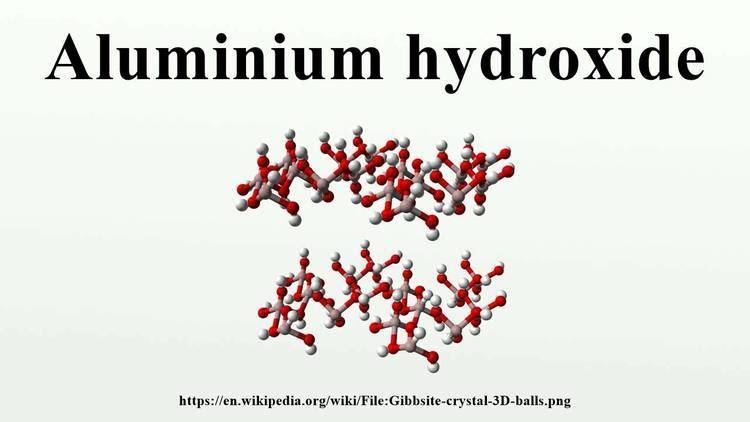
Annual production in 2015 was approximately 170 million tonnes, over 90% of which is converted to aluminium oxide (alumina) that is used in the manufacture of aluminium metal.

The major other uses of aluminium hydroxide is as a feedstock for the manufacture of other aluminium compounds: specialty calcined aluminas, aluminium sulfate, polyaluminium chloride, aluminium chloride, zeolites, sodium aluminate, activated alumina, aluminium nitrate.
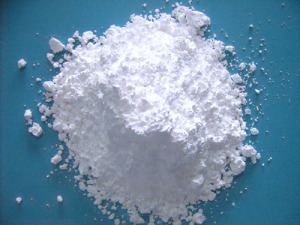
Freshly precipitated aluminium hydroxide forms gels, which are the basis for the application of aluminium salts as flocculants in water purification. This gel crystallizes with time. Aluminium hydroxide gels can be dehydrated (e.g. using water-miscible non-aqueous solvents like ethanol) to form an amorphous aluminium hydroxide powder, which is readily soluble in acids. Aluminium hydroxide powder which has been heated to an elevated temperature under carefully controlled conditions is known as activated alumina and is used as a desiccant, as an adsorbent in gas purification, as a Claus catalyst support for water purification, and as an adsorbent for the catalyst during the manufacture of polyethylene by the Sclairtech process.
Fire retardant

Aluminium hydroxide also finds use as a fire retardant filler for polymer applications in a similar way to magnesium hydroxide and mixtures of huntite and hydromagnesite. It decomposes at about 180 °C (356 °F), absorbing a considerable amount of heat in the process and giving off water vapour. In addition to behaving as a fire retardant, it is very effective as a smoke suppressant in a wide range of polymers, most especially in polyesters, acrylics, ethylene vinyl acetate, epoxies, PVC and rubber.
Pharmaceutical

Under the generic name algeldrate, aluminium hydroxide is used as an antacid. Aluminium hydroxide is preferred over other alternatives such as sodium bicarbonate because Al(OH)3, being insoluble, does not increase the pH of stomach above 7 and hence, does not trigger secretion of excess acid by the stomach. Brand names include Alu-Cap, Aludrox, Gaviscon or Pepsamar. It reacts with excess acid in the stomach, reducing the acidity of the stomach content, which may relieve the symptoms of ulcers, heartburn or dyspepsia. Such products can cause constipation, because the aluminum ions inhibit the contractions of smooth muscle cells in the gastrointestinal tract, slowing peristalsis and lengthening the time needed for stool to pass through the colon. Some such products (such as Maalox) are formulated to minimize such effects through the inclusion of equal concentrations of magnesium hydroxide or magnesium carbonate, which have counterbalancing laxative effects. This compound is also used to control phosphate (phosphorus) levels in the blood of people suffering from kidney failure.

Precipitated aluminium hydroxide is included as an adjuvant in some vaccines (e.g. anthrax vaccine). One of the well-known brands of aluminium hydroxide adjuvant is Alhydrogel, made by Brenntag Biosector. Since it absorbs protein well, it also functions to stabilize vaccines by preventing the proteins in the vaccine from precipitating or sticking to the walls of the container during storage. Aluminium hydroxide is sometimes mistakenly called "alum", which properly refers to aluminium potassium sulfate.
Vaccine formulations containing aluminium hydroxide stimulate the immune system by inducing the release of uric acid, an immunological danger signal. This strongly attracts certain types of monocytes which differentiate into dendritic cells. The dendritic cells pick up the antigen, carry it to lymph nodes, and stimulate T cells and B cells. It appears to contribute to induction of a good Th2 response, so is useful for immunizing against pathogens that are blocked by antibodies. However, it has little capacity to stimulate cellular (Th1) immune responses, important for protection against many pathogens, nor is it useful when the antigen is peptide-based.
Potential adverse effects
In the 1960s and 1970s it was speculated that aluminium was related to various neurological disorders including Alzheimer's disease. Since then, multiple epidemiological studies have found no connection between exposure to aluminium and neurological disorders.
